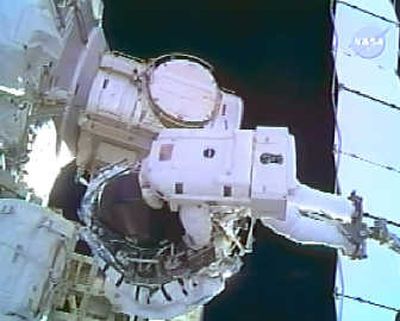Shuttle gouge no threat to crew, NASA says

HOUSTON – NASA managers said Monday that damage to Shuttle Endeavour’s thermal tiles does not pose a threat to the crew.
However, the space agency did activate a team of astronauts, engineers and other specialists Monday to begin mapping out the steps necessary for a spacewalk repair if it is deemed necessary.
A final decision on whether to fix a 3 1/2-inch gouge on the orbiter’s belly will not be made before Wednesday.
“This damage does not meet the criteria of, ‘We think the astronauts are in jeopardy,’ ” said John Shannon, chairman of the mission management team. “This is a case where you want to do the prudent thing for the vehicle.”
Shuttle managers are weighing two main risks:
If they do nothing, the damaged area could worsen during the extreme heat of Endeavour’s re-entry into Earth’s atmosphere.
If they send an astronaut or two on a spacewalk to repair the gouge, the crew could inadvertently damage other tiles on the orbiter’s belly.
A spacewalking astronaut wears a bulky 300-pound suit and carries about 150 pounds of dangling tools.
“Obviously, any of those things dinging into the tile underneath potentially could damage the tile,” said Paul Boehn, lead spacewalk officer.
Ice behind a bracket on Endeavour’s external fuel tank knocked off a baseball-size piece of foam 58 seconds after launch Wednesday.
It ricocheted off a strut connecting the shuttle and tank. Then it pierced the edges of two adjacent thermal tiles, exposing a sliver of the feltlike material underneath.
On Monday, Shannon said analysts still were not sure if it was just foam or a mixture of foam, ice or a denser underlying tank foam.
The gouge near the starboard main landing-gear door just under the right wing is directly over one of the aluminum ribs of the wing’s skeleton, giving some reassurance to shuttle managers. The aluminum ribs, Shannon explained, would help disperse any heat that would come into the damaged area.
The 15-story external fuel tank has shed foam and ice debris ever since shuttles began flying in 1981, and has been a source of much debate within the agency for years.
In 2003, a chunk flew off the tank, damaging Columbia’s left wing and causing the orbiter to burn up during re-entry. None of the crew’s seven members survived.
The debris damages an average of 100 thermal tiles on each shuttle flight. Often that debris comes off in tiny “popcorn” pieces, but it can be as large as the baseball-size chunk that struck Endeavour or even the briefcase-size one that punched the fatal hole in Columbia’s wing.